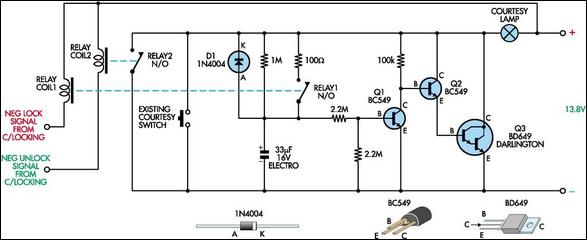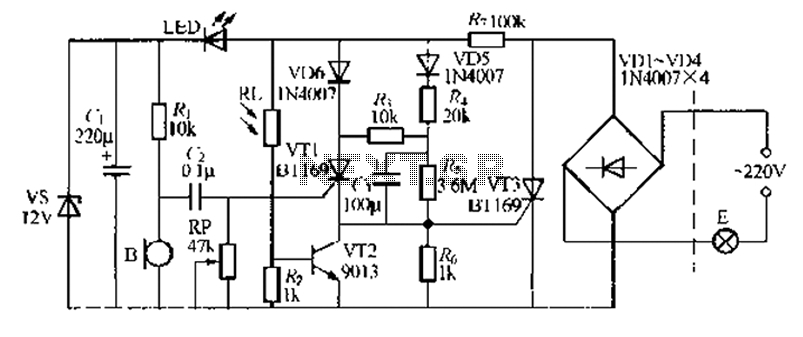
Courtesy Light Extender

This circuit functions as a courtesy light extender for automobiles, with a duration of 15 to 20 seconds. It is triggered by the opening of a door and also detects negative lock/unlock signals from a car alarm or central locking system. Upon receiving an unlock signal, the circuit activates the courtesy light for 15 to 20 seconds before the door is opened. Conversely, upon receiving a lock signal, the courtesy light is turned off immediately without any fade-out to prevent false triggering of the burglar alarm due to current drain sensing. When the car door is open or the unlock relay is activated, a 33 µF capacitor discharges through diode D1, keeping transistor Q1 in the off state, which allows transistors Q2 and Q3 to activate the courtesy lamp. Once the door is closed, the courtesy lamp remains on while the 33 µF electrolytic capacitor begins to charge through a 1 MΩ resistor. As the voltage increases, Q1 gradually turns on, which in turn deactivates Q2 and Q3, resulting in a gradual fade-out of the courtesy lamp. If a lock signal is received from the central locking system, relay 1 engages, charging the capacitor instantly and causing the lamp to turn off immediately. Relays are employed to interface with the central locking and alarm system as a safety measure to provide isolation in the event of a malfunction.
The circuit employs a combination of capacitors, resistors, and transistors to manage the operation of the courtesy light effectively. The 33 µF capacitor plays a critical role in timing the light duration and controlling the fade-out effect. The use of diode D1 prevents backflow of current, ensuring that the discharge path is well-defined when the door is opened. The transistors Q1, Q2, and Q3 are configured in a manner that allows for both the activation and gradual deactivation of the courtesy light, enhancing user experience by providing adequate illumination when entering or exiting the vehicle.
The relay system adds a layer of safety, ensuring that the courtesy light function does not interfere with the car's alarm system. By isolating the circuit from the central locking mechanism, potential issues such as inadvertent activation or failure of the alarm system are mitigated. The 1 MΩ resistor serves to limit the charging current of the capacitor, allowing for a controlled rise in voltage that dictates the timing of the light's fade-out. Overall, this circuit design provides a practical solution for extending courtesy light functionality while maintaining compatibility with existing vehicle security systems.In essence, this circuit is a 15 to 20-second courtesy light extender for cars. It is activated in the usual way by opening a door but it also samples the negative lock/unlock signals from a car alarm or central locking and does two more things. First, when an unlock signal is received, it turns on the courtesy light for 15-20 seconds before you o
pen the door. Second, when a lock signal is received, it turns off the courtesy light immediately, with no fade-out. This is done to eliminate false triggering of the burglar alarm through current drain sensing. When a car door is open or the unlock relay is activated, the 33 µF capacitor discharges through diode D1 and this keeps transistor Q1 turned off.
This allows Q2 and Q3 to turn on and the courtesy lamp is activated. When the door is closed, the courtesy lamps stay illuminated and the 33 µF electrolytic capacitor starts charging through the associated 1MO resistor. As the voltages rises, Q1 turns on slowly, turning off Q2 and Q3 which gradually fades out the courtesy lamp.
If a lock signal from the central locking system is received, relay 1 closes and charges the capacitor instantly, so the lamp turns off immediately. Relays were used to interface to the central locking/alarm system as a safety feature, to provide isolation in case something goes wrong.
🔗 External reference
The circuit employs a combination of capacitors, resistors, and transistors to manage the operation of the courtesy light effectively. The 33 µF capacitor plays a critical role in timing the light duration and controlling the fade-out effect. The use of diode D1 prevents backflow of current, ensuring that the discharge path is well-defined when the door is opened. The transistors Q1, Q2, and Q3 are configured in a manner that allows for both the activation and gradual deactivation of the courtesy light, enhancing user experience by providing adequate illumination when entering or exiting the vehicle.
The relay system adds a layer of safety, ensuring that the courtesy light function does not interfere with the car's alarm system. By isolating the circuit from the central locking mechanism, potential issues such as inadvertent activation or failure of the alarm system are mitigated. The 1 MΩ resistor serves to limit the charging current of the capacitor, allowing for a controlled rise in voltage that dictates the timing of the light's fade-out. Overall, this circuit design provides a practical solution for extending courtesy light functionality while maintaining compatibility with existing vehicle security systems.In essence, this circuit is a 15 to 20-second courtesy light extender for cars. It is activated in the usual way by opening a door but it also samples the negative lock/unlock signals from a car alarm or central locking and does two more things. First, when an unlock signal is received, it turns on the courtesy light for 15-20 seconds before you o
pen the door. Second, when a lock signal is received, it turns off the courtesy light immediately, with no fade-out. This is done to eliminate false triggering of the burglar alarm through current drain sensing. When a car door is open or the unlock relay is activated, the 33 µF capacitor discharges through diode D1 and this keeps transistor Q1 turned off.
This allows Q2 and Q3 to turn on and the courtesy lamp is activated. When the door is closed, the courtesy lamps stay illuminated and the 33 µF electrolytic capacitor starts charging through the associated 1MO resistor. As the voltages rises, Q1 turns on slowly, turning off Q2 and Q3 which gradually fades out the courtesy lamp.
If a lock signal from the central locking system is received, relay 1 closes and charges the capacitor instantly, so the lamp turns off immediately. Relays were used to interface to the central locking/alarm system as a safety feature, to provide isolation in case something goes wrong.
🔗 External reference





